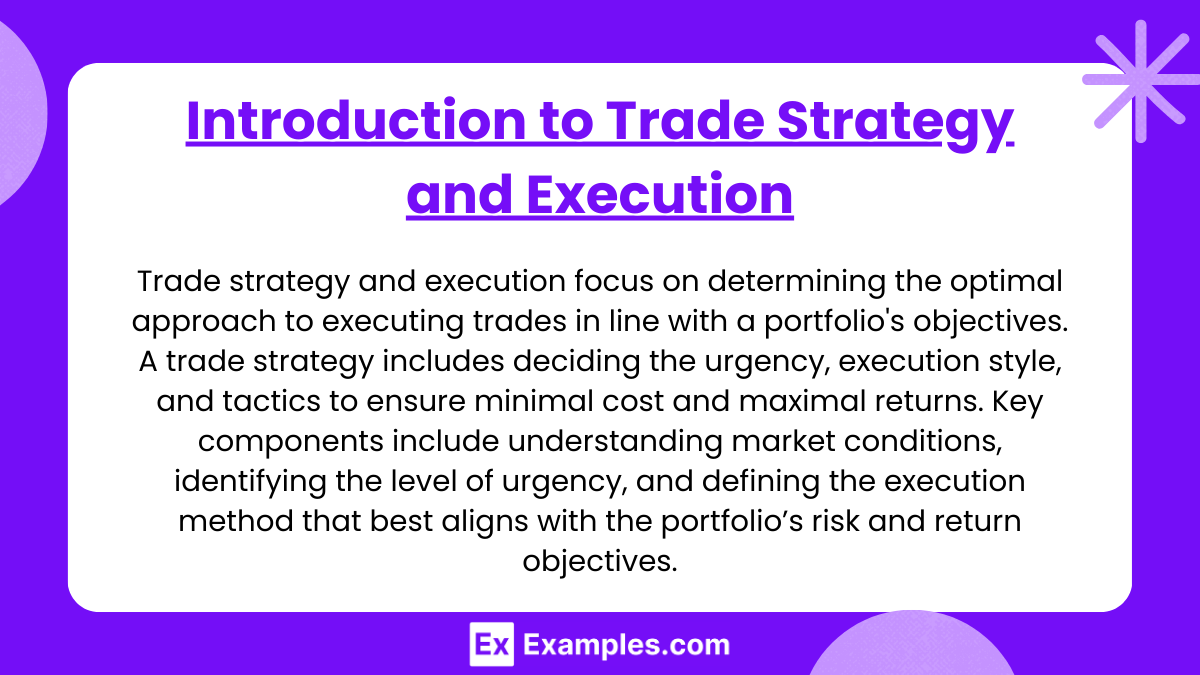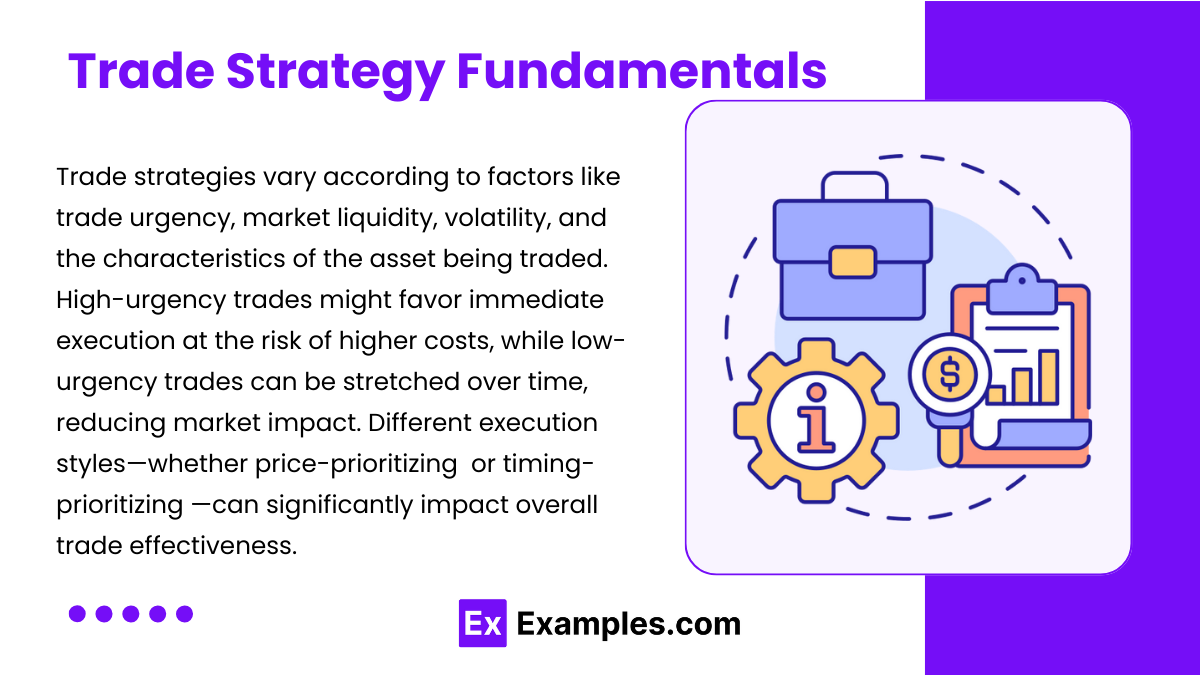Trade Strategy and Execution

- Notes
“Trade Strategy and Execution” is a vital topic in portfolio management, focusing on the planning and operational decisions required to execute trades effectively. The objective is to balance minimizing execution costs, such as slippage, market impact, and commissions, while achieving targeted exposure. For CFA candidates, mastering trade strategy is crucial, as skilled execution can significantly improve portfolio performance. Understanding trade strategy enables portfolio managers to align individual trades with broader investment goals, ensuring that trade timing, costs, and market impacts are optimized.
Learning Objective
In studying “Trade Strategy and Execution” for the CFA exam, you will learn to assess various trading strategies and methods of execution, taking into account factors such as urgency, market conditions, and asset liquidity. You will analyze how different trade execution strategies impact costs, including explicit and implicit costs, and learn techniques to minimize these costs. Additionally, you will evaluate the role of trade execution technology and its effect on market efficiency, while applying your knowledge to develop effective trade strategies that optimize return and minimize cost in real-world trading scenarios.
Introduction to Trade Strategy and Execution

Trade strategy and execution focus on determining the optimal approach to executing trades in line with a portfolio’s objectives. A trade strategy includes deciding the urgency, execution style, and tactics to ensure minimal cost and maximal returns. Key components include understanding market conditions, identifying the level of urgency, and defining the execution method that best aligns with the portfolio’s risk and return objectives.
Trade Strategy Fundamentals

Trade strategies vary according to factors like trade urgency, market liquidity, volatility, and the characteristics of the asset being traded. High-urgency trades might favor immediate execution at the risk of higher costs, while low-urgency trades can be stretched over time, reducing market impact. Different execution styles—whether price-prioritizing (focusing on reducing transaction costs) or timing-prioritizing (targeting favorable market conditions)—can significantly impact overall trade effectiveness.
Execution Costs in Trade Strategy

Execution costs encompass both direct and indirect expenses that impact portfolio returns. Key types of execution costs include:
- Explicit Costs: These are direct costs like commissions and fees paid to brokers for trade execution.
- Implicit Costs: These include market impact, bid-ask spread, and opportunity costs. Market impact refers to the price movement caused by the trade itself, while the bid-ask spread is the natural cost difference in trading. Opportunity cost arises when a trader misses out on favorable prices due to delayed execution.
- Slippage: Slippage occurs when there’s a difference between the expected trade price and the actual price at which the trade is executed, especially in volatile markets.
Trade Execution Approaches

Trade execution approaches vary depending on the trader’s goals, such as immediacy, low cost, or precision. The common types include:
- Market Orders: Executed immediately at current market prices, suited for high-urgency trades, though potentially incurring high costs.
- Limit Orders: Set to execute only at a specified price, providing control over cost but potentially leading to missed trades if prices don’t reach the set level.
- Algorithmic Trading: Involves using automated systems to execute trades based on predefined parameters, reducing human error and optimizing timing and cost-efficiency.
- VWAP and TWAP: Volume-Weighted Average Price (VWAP) and Time-Weighted Average Price (TWAP) are commonly used strategies to minimize market impact by executing large orders over a specific period or according to average price targets.
Role of Technology in Trade Execution
Technological advancements have transformed trade execution, making it faster, more precise, and more cost-effective. Algorithmic trading systems enable traders to execute large volumes while minimizing market impact and reducing human error. High-frequency trading and real-time analytics further enhance decision-making, allowing for better market timing and cost optimization.
Examples
Example 1
A portfolio manager needs to execute a high-urgency trade to rebalance a portfolio. Choosing a market order allows for immediate execution but could incur higher costs due to market impact and slippage.
Example 2
To acquire shares of a low-liquidity small-cap stock, a trader uses a limit order to avoid paying excessive premiums. However, this could lead to missed trades if the stock does not reach the specified limit price.
Example 3
An institutional investor uses an algorithmic trading strategy to execute a large block of shares, ensuring the trade’s cost efficiency by spreading it across the day and reducing the chance of adverse price movements.
Example 4
A trader implements a VWAP strategy to purchase shares over a set period, aiming to minimize market impact by executing portions of the trade at prices close to the day’s average volume price.
Example 5
During volatile market conditions, a portfolio manager uses a TWAP strategy to evenly distribute a trade across several hours, ensuring minimal price disruption and averaging the trade price over time.
Practice Questions
Question 1
What is the primary advantage of using a limit order for trade execution?
A) It allows for immediate execution regardless of price
B) It minimizes slippage in volatile markets
C) It ensures the trade is executed at a specified or better price
D) It reduces the impact of high-frequency trading
Answer: C) It ensures the trade is executed at a specified or better price
Explanation: Limit orders allow traders to set a maximum price to buy or a minimum price to sell, providing control over trade execution costs and preventing purchases or sales outside the desired price range.
Question 2
Which of the following best describes slippage in trade execution?
A) The cost difference between the bid and ask prices
B) The discrepancy between expected and actual trade prices
C) The additional fee charged by brokers for large trades
D) The opportunity cost of not executing a trade
Answer: B) The discrepancy between expected and actual trade prices
Explanation: Slippage refers to the difference between the anticipated price of a trade and the price at which it is actually executed, often occurring in fast-moving or illiquid markets.
Question 3
Which trading strategy would be most appropriate for minimizing market impact when executing a large order over a trading day?
A) Market order
B) Limit order
C) TWAP
D) High-frequency trading
Answer: C) TWAP
Explanation: A Time-Weighted Average Price (TWAP) strategy spreads the execution of a large order evenly across a specified period, helping to reduce market impact by avoiding significant price changes.

